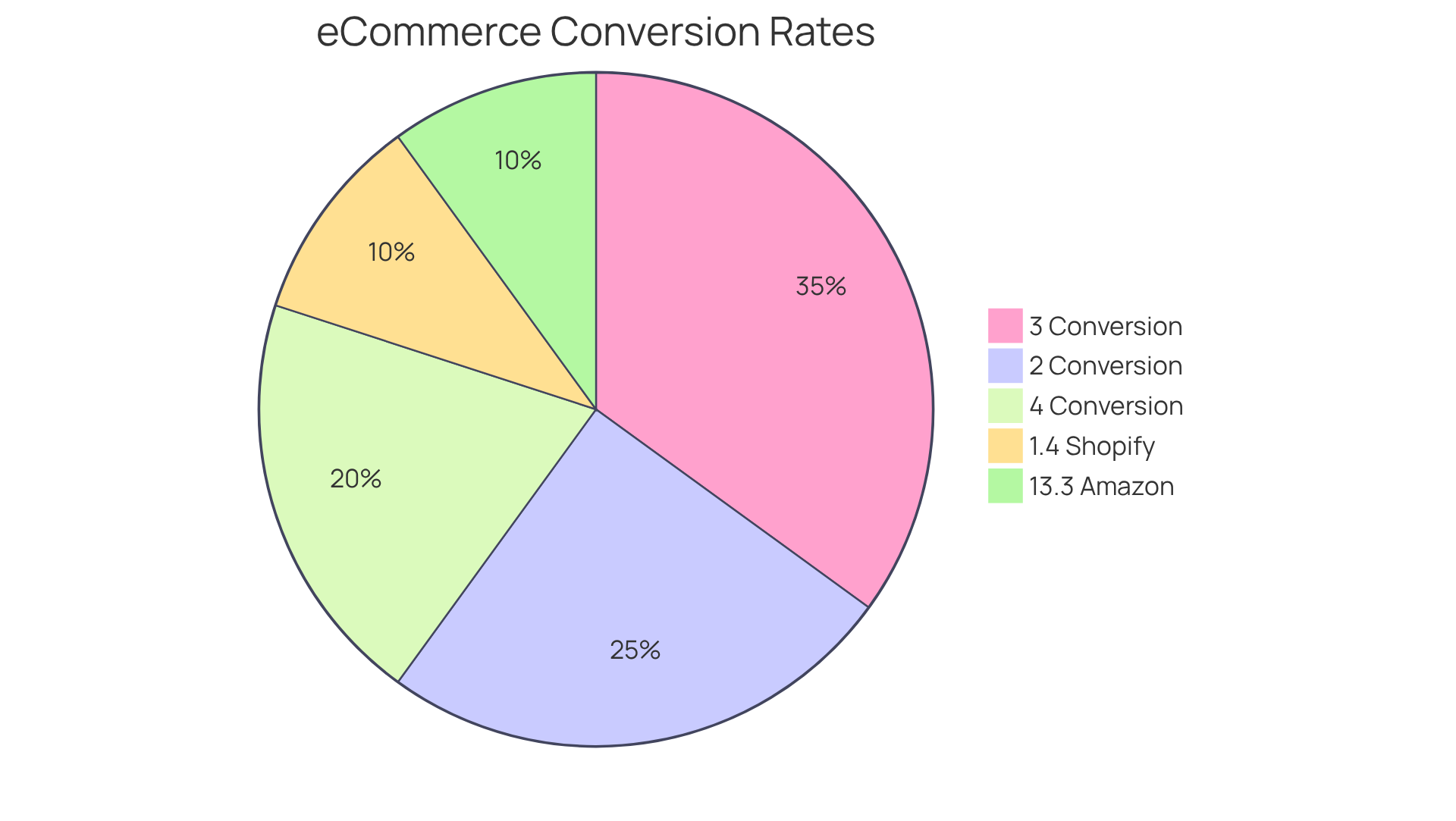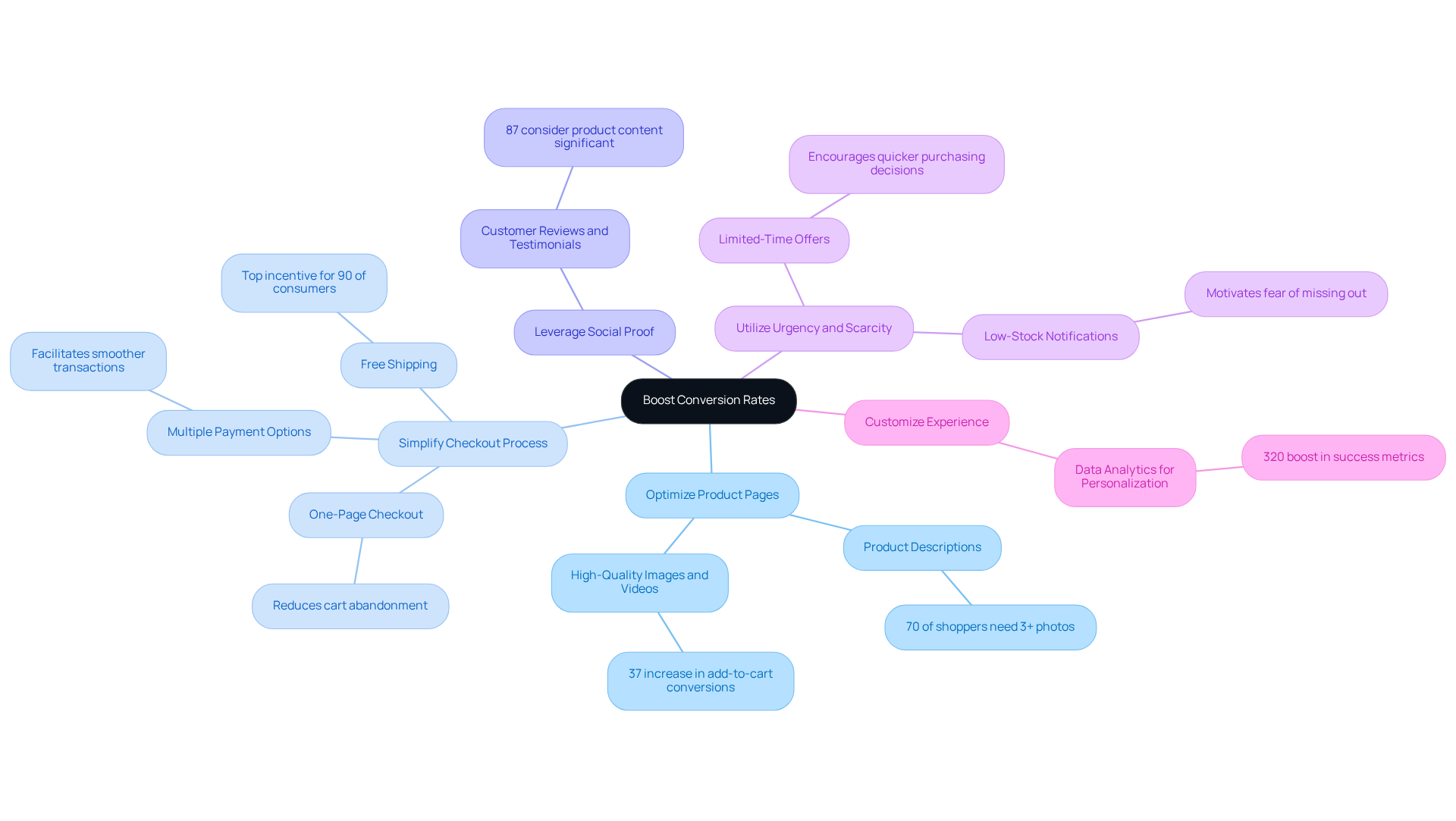
Overview
This article presents proven strategies for increasing conversion rates in eCommerce, underscoring the critical need to:
- Optimize product pages
- Simplify the checkout process
- Leverage social proof
- Apply psychological insights
Each strategy is backed by compelling data and case studies that illustrate their effectiveness. For instance, high-quality visuals and streamlined user experiences have been shown to significantly boost conversions, ultimately driving sales and enhancing competitive positioning in the market.
By focusing on these strategies, eCommerce businesses can not only improve their conversion rates but also create a more engaging shopping experience for their customers. The importance of optimizing product pages cannot be overstated; they serve as the first impression for potential buyers. Simplifying the checkout process reduces friction, making it easier for customers to complete their purchases. Additionally, leveraging social proof—such as customer reviews and testimonials—can build trust and encourage new customers to take the plunge.
Moreover, utilizing psychological insights allows businesses to tap into the motivations and behaviors of their customers, further enhancing the shopping experience. The data speaks for itself: businesses that implement these strategies see a marked increase in conversions.
In conclusion, by adopting these proven strategies, eCommerce businesses can significantly enhance their sales performance and strengthen their market position. It's time to take action and implement these insights to reap the benefits of a more effective eCommerce strategy.
Introduction
Understanding eCommerce conversion rates is crucial for brands aiming to excel in a competitive digital landscape. These metrics not only reflect the effectiveness of marketing strategies but also provide significant insights into customer behavior, making them essential for driving sales. With typical conversion rates hovering between 2% and 4%, many brands face the pressing challenge of improving these figures.
What proven strategies can eCommerce businesses implement to enhance conversion rates and ultimately achieve greater success? By focusing on actionable insights and leveraging data-driven approaches, brands can transform their conversion rates and thrive in the digital marketplace.
Understand eCommerce Conversion Rates and Their Importance
Conversion metrics in eCommerce represent a critical measure of success, indicating the percentage of visitors who complete a desired action, such as making a purchase. As we look ahead to 2025, typical conversion rates generally range from 2% to 4%, varying by sector. For instance, a brand that achieves a 3% conversion rate effectively converts three out of every 100 visitors into customers.
Understanding these metrics is essential for eCommerce brands aiming at increasing conversion rate ecommerce. They reveal the effectiveness of marketing strategies and the overall customer experience. By benchmarking against industry standards, brands can identify performance gaps and set realistic improvement goals. This foundational knowledge empowers brands to implement targeted strategies that enhance user engagement, driving sales and increasing conversion rate ecommerce.
Ultimately, mastering conversion metrics not only contributes to a brand's success but also positions it competitively in the market. By focusing on these key performance indicators, eCommerce businesses can refine their approaches, ensuring they meet and exceed customer expectations.

Implement Proven Strategies to Boost Conversion Rates
To effectively boost conversion rates, eCommerce brands must implement strategic approaches that command attention and drive action:
-
Optimize Product Pages: Crafting clear, engaging, and informative product descriptions is essential. High-quality images and videos significantly enhance the shopping experience. In fact, studies reveal that product pages featuring videos see a remarkable 37% increase in add-to-cart conversions. Moreover, 70% of shoppers require at least three product photos before making a purchase, highlighting the critical role of visual content.
-
Simplify the Checkout Process: Streamlining the checkout process is vital. Reducing the number of steps required to complete a purchase can dramatically decrease cart abandonment rates, which hover around 75%. Implementing a one-page checkout and offering multiple payment options facilitate smoother transactions, catering to diverse customer preferences. Notably, research indicates that complimentary shipping is a leading motivator for 9 out of 10 shoppers, making it imperative to incorporate this into checkout methods.
-
Leverage Social Proof: Displaying customer reviews and testimonials prominently on product pages builds trust and encourages purchases. Research shows that 87% of consumers consider product content highly significant in their purchasing decisions, which is essential for increasing conversion rate ecommerce through effective social proof.
-
Utilize Urgency and Scarcity: Creating a sense of urgency through limited-time offers or low-stock notifications can prompt quicker purchasing decisions. Consumers are often motivated by the fear of missing out, making these strategies particularly effective.
-
Customize Experience: Utilizing data analytics to tailor product recommendations and marketing messages to individual preferences can yield impressive results. Customization has been shown to result in a staggering 320% boost in success metrics, as customers are more inclined to engage with content that resonates with their unique needs and interests.

Enhance User Experience Through Psychological Insights
Improving customer experience (UX) through psychological insights is not just beneficial; it can significantly contribute to increasing conversion rate ecommerce. Here are key psychological principles that every brand owner should consider:
-
Cognitive Load Reduction: Simplifying navigation and minimizing the amount of information presented at once is essential to prevent overwhelming individuals. A clean, intuitive layout aids in decision-making and enhances overall satisfaction, thereby contributing to increasing conversion rate ecommerce. Studies show that decreasing cognitive load can lead to greater engagement and success, which is crucial for increasing conversion rate ecommerce, as individuals feel more at ease navigating the site. For instance, a $30M clothing brand collaborated with Parah Group to revamp their homepage, emphasizing social validation and testimonials, which ultimately resulted in a 35% rise in sales rates.
-
Emotional Triggers: Leveraging emotional appeals in marketing messages and product descriptions effectively motivates purchases. Highlighting benefits and evoking positive emotions—such as joy or trust—resonates with consumers, which is essential for increasing conversion rate ecommerce as it makes them more likely to complete a transaction. Parah Group's strategies included gamifying the shopping experience and offering complimentary gifts, boosting engagement and leading to a 10% rise in revenue per visitor for their clients.
-
Reciprocity Principle: Providing free trials, samples, or valuable content cultivates a sense of obligation among individuals, enhancing conversion chances. This principle taps into the innate human inclination to return favors, which is a powerful tool for increasing conversion rate ecommerce. For example, STRNG Seeds, a fast-growing DTC cannabis brand, implemented free gifts over a certain cart size, improving their average order value (AOV) by 90%.
-
Anchoring Effect: Presenting a higher-priced item alongside a more reasonably priced option can make the latter seem more appealing. This approach influences buying choices by shaping the perceived worth of items, steering individuals toward selections that match their budget and preferences. Parah Group's price testing methods were instrumental in increasing conversion rate ecommerce, as they helped clients identify optimal price points, resulting in substantial increases in AOV and sales rates.
-
Trust Signals: Incorporating trust badges, secure payment icons, and clear return policies alleviates consumer anxiety and builds confidence in the purchasing process. Establishing credibility through social proof, including customer testimonials and reviews, enhances trust and is essential for increasing conversion rate ecommerce, making individuals more comfortable with their purchasing choices. Case studies demonstrate that brands effectively utilizing social proof experienced significant enhancements in their performance metrics, reinforcing the importance of trust signals in eCommerce.
By applying these psychological concepts and learning from successful case studies, DTC brand owners can significantly enhance their user experience, which is key for increasing conversion rate ecommerce and driving substantial advancements in sales.

Utilize A/B Testing and Data Analysis for Ongoing Optimization
A/B testing and data analysis are essential components of a robust optimization strategy that drives better results. Here’s how to implement these practices effectively:
-
Identify Key Metrics: Focus on metrics that align with your business objectives, such as transaction figures, average order value (AOV), click-through rates, and bounce rates. These indicators offer a comprehensive view of your eCommerce performance, enabling you to track progress effectively.
-
Conduct A/B Tests: Regularly experiment with various elements of your website, including headlines, images, and call-to-action (CTA) buttons. For example, testing different button colors can reveal which version generates more clicks, enhancing engagement. A/B testing is also vital for increasing conversion rate ecommerce by pinpointing problematic checkout elements and reducing cart abandonment, making it a cornerstone of conversion rate optimization.
-
Examine Visitor Behavior: Leverage tools like heatmaps and session recordings to gain insights into user interactions on your site. This analysis uncovers critical areas for improvement, guiding necessary design and functionality adjustments. Understanding consumer behavior is crucial for enhancing the overall experience.
-
Iterate Based on Findings: Use insights from A/B testing and consumer behavior analysis to implement data-driven modifications to your website and marketing strategies. Continuous iteration is key to improving success metrics and adapting to user preferences. However, beware of analysis paralysis; concentrate on actionable metrics that align with your goals to avoid being overwhelmed by data.
-
Monitor Industry Trends: Stay informed about eCommerce trends and benchmarks to ensure your strategies remain effective in a dynamic market. Grasping industry standards can help refine your approach and maintain a competitive edge. Experts emphasize that A/B testing is vital for enhancing customer experience and is essential for increasing conversion rate ecommerce, making it an indispensable tool for DTC brands.

Conclusion
Understanding and improving eCommerce conversion rates is essential for brands that want to excel in a competitive market. Tracking these metrics is just the beginning; implementing targeted practices to enhance user engagement and drive sales is where the real impact lies. By optimizing product pages, simplifying the checkout process, leveraging social proof, and applying psychological insights, brands can significantly elevate their conversion rates and overall success.
Key insights underscore the necessity of continuous improvement through A/B testing and data analysis. Identifying key metrics, conducting experiments, and iterating based on findings allow eCommerce businesses to adapt to consumer behavior and preferences, ensuring they stay relevant in a dynamic market. Integrating psychological principles enriches the user experience, making shopping more intuitive and enjoyable.
Ultimately, increasing conversion rates requires a holistic approach that combines strategic optimization, psychological understanding, and data-driven decision-making. Embracing these proven strategies not only enhances the shopping experience but also positions brands for long-term success. A commitment to refining these elements can lead to substantial growth in sales and customer loyalty, reinforcing the critical role of conversion rates in eCommerce.
Frequently Asked Questions
What are eCommerce conversion rates?
eCommerce conversion rates represent the percentage of visitors who complete a desired action, such as making a purchase.
What is the typical range for conversion rates in eCommerce?
Typical conversion rates generally range from 2% to 4%, varying by sector.
How is a conversion rate calculated?
A conversion rate is calculated by dividing the number of conversions (e.g., purchases) by the total number of visitors and then multiplying by 100 to get a percentage.
Why are conversion rates important for eCommerce brands?
Conversion rates are important because they indicate the effectiveness of marketing strategies and the overall customer experience, helping brands identify performance gaps and set realistic improvement goals.
How can eCommerce brands improve their conversion rates?
Brands can improve their conversion rates by implementing targeted strategies that enhance user engagement and refine their approaches based on performance metrics.
What role do industry benchmarks play in understanding conversion rates?
Industry benchmarks help brands identify performance gaps and set realistic improvement goals by comparing their conversion rates to those of similar businesses.
How does mastering conversion metrics benefit eCommerce businesses?
Mastering conversion metrics contributes to a brand's success and positions it competitively in the market, allowing businesses to meet and exceed customer expectations.
FAQs











